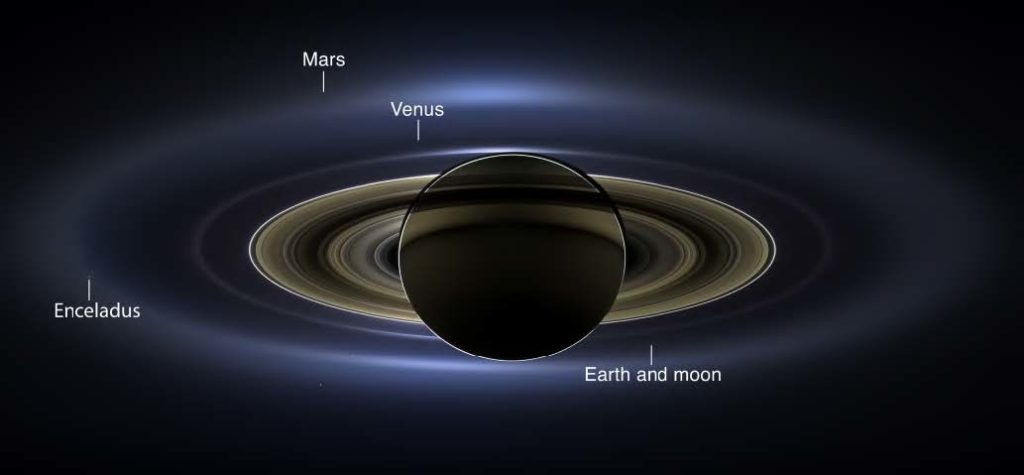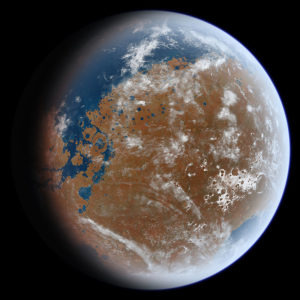Where’s the Water in Our Solar System?
by Dr Tanya Hill, Senior Curator of Astronomy at Museums Victoria
NASA has a saying – “follow the water” – because wherever there is water here on Earth, we find life. Water provides an ideal environment for life to flourish. But even more importantly, all life on Earth can’t exist without water.
From tiny bacteria to giant blue whales, the chemical reactions going on inside all living things – including us – that keep them alive cannot happen without water. By taking NASA’s lead and following the water, scientists can pinpoint the most compelling locations where life – either past or present – might possibly exist beyond our home planet.
There’s no place like home
Water, in all its various forms – liquid oceans and seas, ice sheets and glaciers, and water vapour in the atmosphere – helps to make Earth a great place to live. If it weren’t for the oceans absorbing the heat of the Sun and spreading that heat around the globe, our planet would be unbearably hot. Conversely, water vapour in the atmosphere ensures that our planet never gets too cold. By trapping heat in the atmosphere, it acts like a blanket keeping us warm throughout the night.
Driven by water in the seas and skies, Earth’s climate is just right – not too hot and not too cold. But we are in danger of critically upsetting this delicate balance.
Dry, rocky terrestrials
On the surface it appears that the Earth has an abundance of water. Oceans cover 70% of our planet. But in reality, our world is very dry. If we stripped the Earth of all its water – from the oceans, lakes and rivers, groundwater, ice sheets, water vapour in the atmosphere, and even the water found in all living beings – and scooped it up to form a ball, that ball would be just 1,400km across or about nine times smaller than the barren, rocky Earth. Amazingly, very little water is needed for life to thrive.
Earth, along with the other terrestrial planets – Mercury, Venus and Mars – are all rocky worlds without much water. Of these Venus is the hottest and recent studies have shown that no water persists there. Its thick carbon dioxide atmosphere traps so much heat that the surface temperature remains constant at 460°C, regardless of whether it’s day or night.1 Even in the upper atmosphere where temperatures are cooler, there is extremely little water vapour found.
Mercury, being the closest planet to the Sun, also experiences extremely high temperatures. Without oceans to absorb the Sun’s heat the daytime temperatures reach a scorching 430°C, and without a protective atmosphere to keep warmth in, temperatures plummet to almost -200°C overnight. Mercury therefore is incredibly dry for the most part, but surprisingly, water is hidden in deep, dark craters near Mercury’s north and south poles.2 There, the Sun barely rises above the horizon and sunlight can’t penetrate the crater floors. In 2012, the Messenger spacecraft, which is the only spacecraft to have orbited Mercury, confirmed the presence of water ice in those permanently shadowed craters.
Our Moon, which is similar to Mercury in its extreme temperature swings, has also been found to have frozen lakes of water inside its permanently dark craters. Current lunar exploration is focused on the Moon’s south pole precisely in the hopes of discovering water hidden there. Water on the Moon could be processed for drinking or, by breaking water (H2O) into its hydrogen (H2) and oxygen (O2) components, astronauts could obtain both oxygen for breathing and rocket fuel.
Future astronauts arriving on dusty, red Mars may also have success in finding water. In 2018, the European Space Agency’s Mars Express spacecraft found signs of liquid water in the form of a very salty pond, buried 1,500m near Mars’ south pole.3 This was off the back of NASA’s Phoenix that found the first proof of water on Mars in 2008. But after scraping water ice up from under the planet’s surface, the ice turned into gas that dissipated in a matter of days.4
Beyond the snow line
When the terrestrial planets were forming, around five billion years ago, the inner solar system was too hot for water to survive which is why they are dry and rocky. But within the asteroid belt lies the snow line. Inside this line the asteroid belt lacks water, but beyond it the outer asteroids are icy.
Beyond the snow line and far from the Sun, it was cold enough for water to become integrated into the planets and their moons. In fact, the dwarf planet Ceres is located very close to the snow line and may consist of as much as 25% water – which is more water than found here on Earth even though it is much smaller.5
The ice giants, Uranus and Neptune, are the two most distant planets in the solar system. They appear blue – not because of water – but due to traces of methane in their atmospheres. Hidden below each atmosphere, may be an ocean of boiling water or perhaps a super-hot fog heated by the planets’ cores, which retain the 5000°C heat from when they first formed.6 And since the ice giants are four times larger than Earth, their inner oceans hold more water than all Earth’s oceans combined.
Closer to the Sun, water is found orbiting around the gas giants, Jupiter and Saturn, rather than within the planets themselves.

For Saturn that’s quite literal. The planet’s magnificent rings are composed of water – from tiny grains of ice to frozen boulders about the size of a house. Saturn’s faint outermost ring is fed by water erupting from the tiny moon Enceladus. Only 500 km across, Enceladus was expected to be frozen solid and yet, in 2005 the Cassini spacecraft made one of the most remarkable discoveries of its 10-year mission. It saw plumes erupting from the tiny moon’s surface. Since Cassini was coming to the end of its mission, the spacecraft was sent on a dare-devil dive through the plumes to sample or ‘taste’ the erupting material. It was water, and intriguingly, it was enriched with organic compounds, the building blocks of life.7
Jupiter’s moon Europa has a vast ocean below its icy surface, containing more than double the water on Earth. Hubble Space Telescope images have revealed water being ejected up to 50 km or even 100 km above Europa’s surface, likely because of hydrothermal activity. This means that both Enceladus and Europa have the three ingredients necessary for life: water, nutrients and energy.8
The origin of Earth’s water
The only life that is known to exist is found here on Earth (which is a big responsibility for us!) and that life needs water. Except Earth didn’t always have water, as it formed inside the snow line.
Earth’s water must have been delivered once the Earth had cooled enough and an atmosphere had already formed so that oceans would not merely boil away. Some asteroids, small as they are, contain enough water to provide all of Earth’s water. It’s amazing, but we may only be here because asteroids seeded the early Earth with water that eventually supported life as we know it. But how many asteroids crashed here, and how much water did they each bring? Water from the frozen lakes in craters on the Moon could provide answers about water’s arrival on Earth as the Moon likely received its water around the same time. All that history is now lost on Earth, but it remains frozen in time on the Moon.

Earth wasn’t the only terrestrial planet to develop oceans. Around 3 billion years ago, Mars likely had an ocean covering nearly a third of its surface.9 But at some point, Mars’ atmosphere was stripped away, causing the oceans to dry up. The Sun continually emits a stream of charged particles known as the solar wind, and these particles speed through the solar system at hundreds of kilometres per second and can strip away a planets’ atmosphere. As the atmosphere on Mars thinned, water evaporated into space or became locked below the surface.
This won’t happen to Earth because our planet is protected by its magnetic field. Particles in the solar wind are deflected by this magnetic field shield, preserving our atmosphere and the oceans below. Unfortunately, Mars’ magnetic field was short-lived and once it had deteriorated, Mars transformed into the dry and dusty planet it is today.
NASA’s quest to “follow the water” was initiated by searching for ancient life on Mars, but it holds true as we explore worlds across the solar system. At Melbourne Planetarium, we have used this quest as the basis of our latest show “Solar System Adventures: Where’s the water?”.10 This guided tour of the solar system uses the planetarium’s remarkable technology to make it feel like you are travelling to these distant worlds beyond Earth.
There’s lots to learn as we explore the solar system, but importantly contemplating our place in the universe also encourages a sense of wonder and awe. It makes us feel small, but in a good way, as we realise that we are connected to something much larger.
Space exploration encourages a renewed appreciation for our own planet, the only known world in the solar system where life is flourishing thanks to that precious resource – water.
References:
- NASA Planetary Fact Sheet. (2023, Sept 4). Solar System Temperatures. science.nasa.gov/resource/solar-system-temperatures/
- MESSENGER – NASA Science. (2017). Science.nasa.gov. science.nasa.gov/mission/messenger
- Orosei, R., et al. (2018). Radar evidence of subglacial liquid water on Mars. Science, 361(6401). doi.org/10.1126/science.aar7268
- Phoenix – NASA Science. (2017). Science.nasa.gov. Retrieved November 14, 2023, from science.nasa.gov/mission/phoenix/
- Ceres – NASA Science. (2018). Science.nasa.gov. science.nasa.gov/mission/dawn/science/ceres
- Wiktorowicz, S., J. & Ingersoll, A., P. (2007). Liquid water oceans in ice giants. Icarus, 186(2). 436-447. doi.org/10.1016/j.icarus.2006.09.003
- NASA. Cassini at Enceladus. science.nasa.gov/mission/cassini/science/enceladus/ Retrieved November 28, 2023.
- Roth, L. (2021). A Stable H2O Atmosphere on Europa’s Trailing Hemisphere From HST Images. Geophysical Research Letters, 48(20). doi.org/10.1029/2021gl094289
- Di Achille, G., & Hynek, B. M. (2010). Ancient ocean on Mars supported by global distribution of deltas and valleys. Nature Geoscience, 3(7), 459–463. doi.org/10.1038/ngeo891
- Solar System Adventures at Melbourne Planetarium. museumsvictoria.com.au/scienceworks/whats-on/solar-system-adventures/






